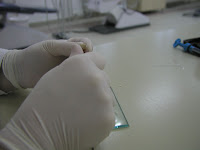Though it is not quite a dental materials subject, I have been involved in clinical testing of electronic apex locators with my colleagues at the University of Belgrade School of Dentistry. This paper has been published in the August issue of the International Endodontic Journal and can be found here. If you have trouble getting access, please email me.
**********************************************************************************
**********************************************************************************
Miletic V, Beljic-Ivanovic K, Ivanovic V. Clinical reproducibility of three electronic apex locators. International Endodontic Journal, 44, 769–776, 2011.
Abstract
Aim To compare the reproducibility of three electronic apex locators (EALs), Dentaport ZX, RomiApex A-15 and Raypex 5, under clinical conditions.
Methodology Forty-eight root canals of incisors, canines and premolars with or without radiographically confirmed periapical lesions required root canal treatment in 42 patients. In each root canal, all three EALs were used to determine the working length (WL) that was defined as the zero reading and indicated by ‘Apex’, ‘0.0’ or ‘red square’ markings on the EAL display. A new K-file of the same size was used for each measurement. The file length was fixed with a rubber stop and measured to an accuracy of 0.01 mm. Measurements were undertaken by two calibrated operators. Differences in zero readings between the three EALs in the same root canal were statistically analysed using paired t-tests with the Bonferroni correction, Bland–Altman plot and Linn’s concordance correlation coefficients at α = 0.05.
Results Mean and standard deviation values measured by the three EALs showed no statistically significant differences. Identical readings by all three EALs were found in 10.4% of root canals. Forty-three per cent of readings differed by less than ±0.5 mm and 31.3% exceeded a difference of ±1 mm.
Conclusions The clinical reproducibility of Dentaport ZX, RomiApex A-15 and Raypex 5 was confirmed with the majority of readings within the ±1.0 mm range. However, the small number of identical zero readings suggests that EALs are not reliable as the sole means of WL determination under clinical conditions.





















